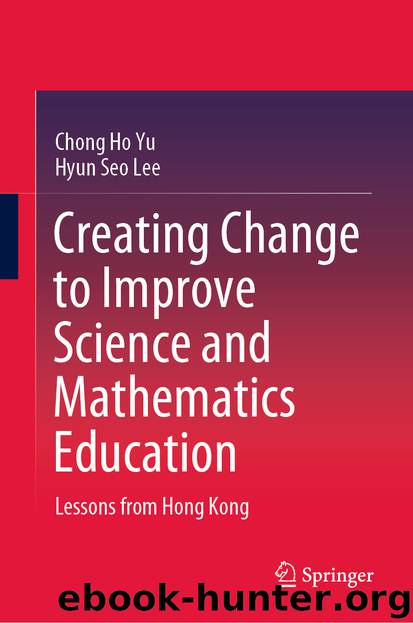Creating Change to Improve Science and Mathematics Education by Chong Ho Yu & Hyun Seo Lee

Author:Chong Ho Yu & Hyun Seo Lee
Language: eng
Format: epub
ISBN: 9789811531569
Publisher: Springer Singapore
4.1 International and the US Approaches Toward Problem-Solving
It is important to point out that Hong Kong education policy makers, as mentioned in Chap. 1, are strongly influenced by international organizations (e.g., OECD), and thus not surprisingly, the Hong Kong approach toward facilitating a problem-solving mindset is based on research conducted in the West, including the US (e.g., Csapó, & Funke, 2017, OECD, 2017). The topic of problem-solving has been thoroughly studied by scholars in the West (e.g., Fischer, Greiff & Funke, 2012; Frensch & Funke, 1995, Funke & Frensch, 2007; Klieme, 2004; Mayer, 1992; Wenke, Frensch, & Funke, 2005). Researchers had already reached a consensus that a complex problem is composed of a nonroutine challenging situation, a goal state (the problem solver would like to rectify the situation in order to accomplish certain objectives), and a solution that is not readily at hand (Mayer & Whittrock, 2006). For example, a CEO of a corporation would like to reduce the environmental footprint of the production line, with the hope of slowing down or even reversing climate change. Needless to say, the problem is so complicated that no textbook-like solution to it exists. With that said, following a set of clear guidelines to report the modal answer is not considered authentic problem-solving. This perspective of problem-solving is in alignment with the view of the US National Council of Teachers of Mathematics (NCTM). According to NCTM (2000), “Problem-solving means engaging in a task for which the solution method is not known in advance. In order to find a solution, students must draw on their knowledge, and through this process, they will often develop new mathematical understandings” (p. 52).
In the 1970s and 1980s, some researchers investigated problem-solving strategies in specific domains, such as physics, writing, and chess-playing (e.g., Anderson, Boyle, & Reiser, 1985; Chi, Feltovich, & Glaser, 1981). They followed the idea developed by Herbert Simon and his associates (Bhaskar & Simon, 1977; Chase & Simon, 1973; Simon & Newell, 1971) that there was no general problem-solving ability, and hence problems in different disciplines require domain-specific knowledge and skill sets. In reaction, Funke and Frensch (2007) questioned whether this approach would hinder researchers from developing a global theory of problem-solving. Although the OECD problem-solving framework was informed by the research tradition of Herbert Simon, it leaned on the importance of global or cross-curricular problem-solving competence (Csapó, & Funke, 2017). To be more specific, in this framework, a proficient Java programmer should be able to debug a C++ or a Python program by applying the same type of logical reasoning, even though he or she never received any formal training in C++ or Python. By the same token, a capable psychology major should work very well in marketing or personnel management in a corporation by transferring his or her knowledge of human behaviors into the job, despite not having taken any class in business. A Chinese idiom shared by many Chinese teachers echoes this problem-solving framework: “When you teach a student ‘one’, he should be able to deduce ‘two and three’ from one”.
Download
This site does not store any files on its server. We only index and link to content provided by other sites. Please contact the content providers to delete copyright contents if any and email us, we'll remove relevant links or contents immediately.
Navigation and Map Reading by K Andrew(5113)
Spare by Prince Harry The Duke of Sussex(5078)
Tuesdays with Morrie by Mitch Albom(4696)
Cracking the GRE Premium Edition with 6 Practice Tests, 2015 (Graduate School Test Preparation) by Princeton Review(4227)
Machine Learning at Scale with H2O by Gregory Keys | David Whiting(4200)
Never by Ken Follett(3801)
Goodbye Paradise(3730)
What It Really Takes to Get Into Ivy League and Other Highly Selective Colleges by Hughes Chuck(3697)
Harry Potter and the Prisoner of Azkaban (Book 3) by J. K. Rowling(3304)
Fairy Tale by Stephen King(3229)
Pledged by Alexandra Robbins(3138)
Kick Ass in College: Highest Rated "How to Study in College" Book | 77 Ninja Study Skills Tips and Career Strategies | Motivational for College Students: A Guerrilla Guide to College Success by Fox Gunnar(3077)
A Dictionary of Sociology by Unknown(3032)
Sapiens and Homo Deus by Yuval Noah Harari(2990)
Reminders of Him: A Novel by Colleen Hoover(2952)
The Social Psychology of Inequality by Unknown(2943)
Graduate Admissions Essays, Fourth Edition: Write Your Way into the Graduate School of Your Choice (Graduate Admissions Essays: Write Your Way Into the) by Asher Donald(2878)
Will by Will Smith(2797)
Zero to Make by David Lang(2727)
